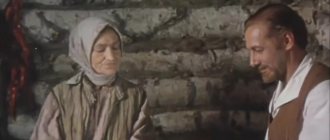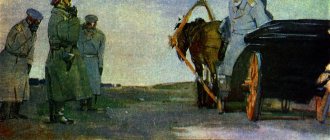Appearance, speech characteristics
The author depicts the heroine’s first appearance on the pages of the story unusually vividly. First, the narrator hears a “fresh, ringing, strong” voice singing a cheerful song. On the threshold of a hut, reminiscent of Baba Yaga’s abode, a tall, beautiful, laughing girl appears, creating a tangible contrast with both the squalor of the situation and the old woman who runs the house. Olesya looks like a forest sorceress, a good fairy: she holds with her hands three tiny birds, which, according to her, have again followed her.
Innate sensitivity to words allows Olesya to figuratively, vividly and accurately formulate her thoughts, describe, and tell. The girl’s speech is evidence of the harmony of her nature, the rare ability to decorate the world around her with her presence alone.
Olesya and Ivan Timofeevich
But real miracles begin when the heroine meets her love (Ivan Timofeevich).
That's how they met. Out of boredom, the young master asked Olesya to tell his fortune. She predicted a sad future for him, a lonely life, and a desire to commit suicide. She said that in the near future the love of the “lady of clubs”, dark-haired, like herself, awaits him. Ivan Timofeevich did not believe her and asked her to show her abilities. Olesya showed him that she could charm blood and instill fear. After this, Ivan, enchanted by the girl, became her frequent guest.
Olesya’s feelings are a great gift to the chosen one of her heart. This love is woven from selflessness and courage of actions, sincerity and purity of thoughts. Knowing that any outcome of the dates will result in terrible grief for her, Olesya gives herself to her lover without looking back.
Olesya decided to go to church, wanting to please her lover, but the peasant women considered her action to be blasphemy and attacked her after the service. The beaten Olesya refused the doctor and decided to leave with her grandmother - so as not to incur even greater anger from the community. She was also convinced that she and Ivan needed to separate, otherwise only grief awaited them. She fails to convince her.
In a hurry, fleeing from her habitable places, dishonored, wounded in body and soul, Olesya does not curse the man who destroyed her, but thanks him for the fleeting happiness that she experienced and felt the magic of true love. Olesya leaves Ivan Timofeevich red beads as a memory of herself.
Character
The mystery surrounding her adds a considerable amount of charm to the forest hermit. Even if the narrator had not heard the story of the witch in the swamps, the image of a girl living alone in the forest, avoiding people, in itself deeply affects the imagination, as do the miracles that she demonstrates. The manners of the mysterious beauty are not similar to the behavior of the local residents and amaze with their natural simplicity and grace. Olesya was distinguished by such character traits as independence, self-will, and love of freedom.
Unfortunately, the limited consciousness characteristic of ordinary people inhabiting Polesie at that time left its mark on the heroine. She sincerely believes that from birth her soul was sold to the devil. This explains her difference from others.
The true meaning of love
He and she in Kuprin’s story “Olesya” are completely different people, so they are not destined to be together. What is the meaning of this love, for the sake of which Olesya, knowing that their relationship was doomed, still did not push the hero away from the very beginning?
Alexander Ivanovich sees the true meaning of love in the desire to give the beloved the fullness of feelings. Man is imperfect, but the great power of this feeling can, at least temporarily, restore to him the naturalness and sharpness of sensations that people like Olesya managed to preserve. This heroine is able to bring harmony to such contradictory relationships as those described by Kuprin (the story “Olesya”). Analysis of this work allows us to conclude that her love is contempt for human suffering and even death. It is a pity that only a select few are capable of such a feeling. Love in Kuprin’s story “Olesya” is a special gift, as rare as the main character possessed. This is something mysterious, mysterious, inexplicable.
Like many great writers, A.I. Kuprin acts in his writings as a “diagnostician” of his contemporary world. And his diagnosis is harsh and final - a person is mired in everyday trifles, has forgotten how to see the great and value real values, has shrunk his soul, has become vulgar in his body. The writer dreams of a person who miraculously escaped the corrupting influence of civilization and retained her natural sincerity. And in these dreams, the charming Olesya appears to him (that’s what the locals called her, and her real name is Alena) - a young 24-year-old witch from a godforsaken outback.
Relationship between Olesya and Ivan Timofeevich
The hero-narrator in “Oles” is a petty official who arrived in a small village on official duties. A young intelligent man who dreams of becoming a writer finds in Oles the embodiment of his romantic ideas. The girl attracted him not only with her bright beauty. Ivan Timofeevich was greatly impressed by the independence and strength of character of the inhabitant of the Polesie swamps. Throughout the story, he is more than once surprised by her self-esteem, thanks to which the forest savage behaves with amazing tact and at the same time with ease and confidence.
The relationship between a representative of the educated class of society and a girl from the common people formed the plot of other works of Russian literature. However, in A.I. Kuprin’s story there is no usual contradiction between a person spoiled by the achievements and possibilities of civilization, and a naive, simple-minded woman, formed away from urban culture.
Olesya did not bore Ivan, like Liza Erast in Karamzin’s story or Bela Pechorin in Lermontov’s novel. She did not frighten the young man with excessive frankness of feelings, like Turgenev’s Asya. On the contrary, the sincere love of a girl unfamiliar with the rules of society delights and attracts the hero. In Kuprin, it is not the confrontation between characters who are socially distant from each other that leads to tragedy.
History of creation
(Publication of the story Olesya, second edition)
A. Kuprin’s story “Olesya” was first published in 1898 in the newspaper “Kievlyanin” and was accompanied by a subtitle. "From memories of Volyn." It is curious that the writer first sent the manuscript to the magazine “Russian Wealth”, since before that this magazine had already published Kuprin’s story “Forest Wilderness”, also dedicated to Polesie. Thus, the author hoped to create a continuation effect. However, “Russian Wealth” for some reason refused to publish “Olesya” (perhaps the publishers were not satisfied with the size of the story, because by that time it was the author’s largest work), and the cycle planned by the author did not work out. But later, in 1905, “Olesya” was published in an independent publication, accompanied by an introduction from the author, which told the story of the creation of the work. Later, the full-fledged “Polessia Cycle” was released, the pinnacle and decoration of which was “Olesya”.
The author's introduction is preserved only in the archives. In it, Kuprin said that while visiting a friend of the landowner Poroshin in Polesie, he heard from him many legends and fairy tales related to local beliefs. Among other things, Poroshin said that he himself was in love with a local witch. Kuprin will later tell this story in the story, at the same time including in it all the mysticism of local legends, the mysterious mystical atmosphere and piercing realism of the situation surrounding him, the difficult fate of the Polesie inhabitants.
Read more: A.I. Kuprin “Olesya”: the history of the story
The reason for the separation of Olesya and Ivan Timofeevich
The reason for the separation of the heroes of the story is the people inhabiting Polesie. The humiliating situation in which the local peasants lived for many years turned them into slaves. The narrator notes the characteristic sullen glance from under his brows, isolation, and silent hostility of the villagers. At the same time, they are already breaking their hats in front of the “master” from afar and bowing respectfully. An enlightened city dweller, Ivan writes with disgust about the “mean manner” of kissing the hands of even the most petty official. Contrary to expectations, he did not record a single Polesie fairy tale, legend or song. Life did not give the local inhabitants a reason for creativity.
Squeezed in the grip of poverty and slavery, the inhabitants of Polesie see the cause of their misfortunes in what they do not understand. They are afraid of everything that does not fit into the framework of the familiar world. Therefore, Olesya’s independence causes hatred in them. Her inner freedom, self-will, and audacity are alien to them. This frightens and worries them.
The “witch”’s attempt to go to church, the desire to join everyone, to become the same, almost killed her. Olesya refuses to leave with the narrator because she is sure: people everywhere are like here and will never allow her to live next to them.
The image and characteristics of Olesya in Kuprin's story Olesya
Olesya is the main character of A.I. Kuprin’s work “Olesya”.
The writer portrayed her as a natural, mysterious girl-witch, as if straight from the pages of a fairy tale. Externally, the girl is described as a very beautiful tall, dark-eyed brunette, twenty-four years old. The original beauty of her face, thick dark hair, beautiful hands, albeit rough from work, a slender and strong body, a fresh and ringing voice, elegance and nobility of manners distinguished her favorably from other village girls.
Alena, or Olesya as she was called, grew up with her grandmother Maynulikha, who, along with her granddaughter, was expelled by the villagers due to suspicions of witchcraft. Life in the forest, away from society and in unity with nature, radically determined her character. Such a life became a paradise for the girl, which she would never exchange for the city.
Olesya is smart, brave and independent. She could stand up for herself in any situation, was not afraid of anything, and had a broad outlook, despite the lack of education. The girl combined such qualities as curiosity, originality, pride, self-confidence and tact.
With the advent of Ivan Timofeevich, Olesya learned what true love is. From the very beginning of communication, the girl realized that a relationship with the young master would not turn out well for her, but still she loved him with all her heart and completely surrendered to her feelings.
For the sake of her loved one, she fulfilled his request to visit church, even though the girl did not like to be in public. In the village, Olesya, like her grandmother, was considered a witch, so visiting the church had sad consequences. The ignorance and hostility of people turned into an attack on the girl, which is why she subsequently had to leave her place of residence.
In his relationship with Ivan Timofeevich, the author revealed in Oles such qualities as tenderness, sensitivity and sacrifice. Her sudden departure without warning once again demonstrated her noble, loving and understanding nature.
The whole image of the girl showed the reader her moral purity, naturalness and sublimity, contrasting her noble character with the hypocrisy and malice of the village inhabitants.
Conclusion
The image of Olesya is the personification of natural freedom. Its tragedy is not due to the traditional romantic confrontation between nature and civilization. This is a conflict between a free person and a slave's worldview. A society accustomed to obedience, not wanting any development, unable to control even its own destiny, intoxicated by the darkest superstitions, hates any free manifestation of the spirit. It seeks to destroy everything unusual, too bright, bold, beautiful, because it threatens to destroy the disgusting but familiar order of things.
Characterizing the image of Olesya can be useful when writing essays and for preparing literature lessons.
The image of the forest witch Olesya in Kuprin’s story of the same name “Olesya”
One of the best works of A.I. Kuprin is the story “Olesya”, which glorifies the purest, most immaculate and true love.
The main character Olesya is an extraordinary girl with a charming appearance. The author writes about her: “The original beauty of her face, once seen, could not be forgotten, but it was difficult, even after getting used to it, to describe it.” Next we learn about her large eyes and dark pink skin tone. The girl is very different from the people around her, she stands out against their background and amazes with her unusual and extraordinary nature.
This impression is confirmed by Ivan Timofeevich when he says that she is: “An integral, free, original nature.” Despite the fact that the young beauty grew up in the forest, and she had no education, she thinks sensibly and uniquely, and delights with her intelligence. After meeting Olesya, the main character was amazed not only by her appearance, but also by the richness of her inner world. The girl asks about everything that interests her. Communicating with Ivan Timofeevich, many things seem unusual, surprising and strange to her. However, she tries to make sense of everything, to understand every point of view. This also does not remain noticed by the main character. He says about her: “You grew up in the forest, not seeing anything. Of course, you couldn’t read much either... And yet you speak so well, no worse than a real young lady.”
Olesya’s feelings for Ivan Timofeevich are as real and natural as she herself. The love of completely different people is based on understanding and awareness of all the shortcomings.
Despite the fact that the forest witch knew that this love would bring her a lot of grief and misfortune, she surrendered to these feelings with all her soul. Such love cannot but cause admiration, because for the sake of her beloved Olesya was ready to do anything. After all, in order to prove her attitude towards her lover, the sorceress goes to church, although she understands how this trip will end for her.
Olesya's fate is tragic. And all because the girl was significantly different from her social environment. She was completely different from the Perbrod peasants. First of all, this was expressed in her pure, open soul and the richness of her inner world. That is why callous and narrow-minded people did not accept the beauty. People like them always strive to get rid of what they do not understand. Therefore, Olesya had to part with her loved one and flee from her native forest.
Story by A.I. Kuprin “Olesya” is a wonderful work that describes true feelings of love. In his work, the author created the image of a woman who delights with her heart, strength of spirit, true natural beauty and romantic nature.



